Best Paint for Baseboards: A Complete Guide to Choosing the Right Option

When it comes to home improvement, painting baseboards is often an overlooked task. However, the best paint for baseboards can dramatically elevate the look of a room. In this guide, we will walk you through choosing the best paint for baseboards, tips for applying it, and the frequently asked questions surrounding baseboard painting.
What is the Best Paint for Baseboards?
Choosing the right paint for baseboards is essential. Baseboards are constantly exposed to wear and tear, which means your paint should be durable and easy to clean. The best paint for baseboards typically offers both longevity and aesthetic appeal. Here are the most popular types:
- Semi-Gloss Paint: Semi-gloss is often considered the best paint for baseboards. It is durable, easy to wipe clean, and has a slight sheen that makes baseboards stand out without being too shiny.
- Satin Paint: Satin paint is also a great option for baseboards. While it is less shiny than semi-gloss, it still provides durability and is easier to clean than flat or matte paints.
- High-Gloss Paint: For a more polished, glossy finish, high-gloss paint works well on baseboards. It is highly reflective, making it easy to clean but might be too shiny for some tastes.
Why Semi-Gloss is the Best Paint for Baseboards
When searching for the best paint for baseboards, semi-gloss stands out for a few reasons. First, it provides a smooth finish that resists moisture and stains. This makes cleaning a breeze. Additionally, the sheen of semi-gloss paint reflects light, making baseboards look clean and fresh without being overpowering. It strikes the perfect balance between durability and aesthetic appeal, making it the top choice for most homeowners.
How to Apply the Best Paint for Baseboards
Once you’ve selected the best paint for your baseboards, it’s time to apply it. The application process is critical for achieving a professional-looking finish. Follow these steps to ensure the paint goes on smoothly and lasts for years.
- Prepare the Area: Clean the baseboards thoroughly to remove dust, dirt, and grime. You can use a damp cloth or mild soap solution. Sand the surface lightly to remove any old paint or imperfections.
- Tape the Edges: Use painter’s tape to protect the walls and floors around your baseboards. This ensures clean, sharp lines when you paint.
- Choose the Right Brush: Use a high-quality, angled paintbrush designed for trim work. This allows you to get into corners and along edges with precision.
- Apply the Paint: Start by applying the paint in long, smooth strokes. Avoid overloading your brush, as this can lead to streaks and drips.
- Allow for Drying Time: Let the paint dry completely between coats. Depending on the paint type, you may need to apply two or more coats for optimal coverage.
Best Paint for Baseboards: Oil-Based vs. Water-Based
One important factor to consider is whether to use oil-based or water-based paint for baseboards. Each has its advantages:
- Oil-Based Paint: Known for its durability and smooth finish, oil-based paint is an excellent choice for baseboards. It resists scuffing and provides a harder, more durable finish. However, it has a strong odor and requires solvents for cleanup.
- Water-Based Paint: Water-based paint is easier to clean and has less odor. It dries quickly and is more environmentally friendly than oil-based paints. However, it may not be as durable, especially for baseboards that receive heavy traffic.
Common Mistakes to Avoid When Painting Baseboards
Even if you’ve chosen the best paint for baseboards, mistakes during application can ruin the final look. Avoid these common errors:
- Skipping Preparation: Cleaning and sanding baseboards before painting is essential for adhesion and a smooth finish.
- Not Using Primer: If you’re changing the color of your baseboards or painting over a dark color, using a primer is crucial. It helps the paint adhere better and provides more uniform coverage.
- Rushing the Process: Take your time when applying the paint. Rushing through the steps can lead to uneven coverage and drips.
Frequently Asked Questions About the Best Paint for Baseboards
1. Can I use wall paint for baseboards?
While you can use wall paint for baseboards, it’s not recommended. Wall paint is typically less durable and harder to clean than paints specifically designed for trim work, like semi-gloss or satin.
2. How long should I wait before applying a second coat of paint?
Most paints need around 2-4 hours to dry before applying a second coat. Always check the manufacturer’s instructions for the best drying times.
3. Can I use a roller instead of a brush?
While a roller can be used, a brush is generally preferred for baseboards. A brush allows for more precision, especially around corners and edges.
4. What color should I paint my baseboards?
The color of your baseboards should complement your room’s overall aesthetic. White and off-white are classic choices, but you can opt for bold colors if you want your baseboards to stand out.
5. How can I keep my baseboards looking clean?
Regular cleaning with a damp cloth will help maintain the paint’s appearance. For stubborn dirt, a mild soap solution should do the trick. Avoid abrasive cleaners that can damage the paint.
Conclusion
In conclusion, choosing the best paint for baseboards is key to achieving a polished, long-lasting finish in your home. Semi-gloss paint is often the top choice due to its durability, ease of cleaning, and subtle sheen. However, the type of paint you choose, whether oil-based or water-based, will depend on your preferences and the amount of traffic the baseboards experience.
By preparing the baseboards correctly, applying the paint carefully, and avoiding common mistakes, you can create a beautiful and durable trim that enhances your room’s overall design. Whether you opt for classic white, bold colors, or sleek finishes, the right paint will make a noticeable difference.